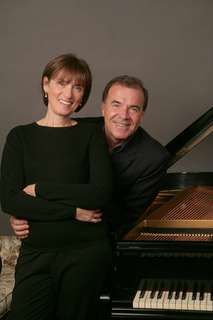|
Back
A Showy Rachmaninoff Evening at the Ravinia Festival Chicago
Martin Theater
07/26/2010 -
Sergei Rachmaninoff: Two pieces for Piano, Six Hands in A Minor (*) – Russian Rhapsody for Two Pianos in E Minor (+) – Suite No. 1 for Two Pianos in G Minor, Op. 5 (+) – Suite No. 2 for Two Pianos in C Major/Minor Op. 17 (#) – Symphonic Dances for Two Pianos, Op. 45 (#)
Marta Aznavoorian (*), Josephine Lee (*), Welz Kauffman (*), Edisher Savitski (+), Vakhtang Kodanashvili (+), Misha Dichter (#), Cipa Dichter (#) (piano) 
Dichter duo (© Christian Steiner)
While there is nothing dainty about Rachmaninoff, there is much beauty and even delicacy in his lines that sing. On July 26 at the Ravinia Festival, an evening of Rachmaninoff for four and six hands delighted an audience at the Martin Theatre, the only structure that remains from the original 1904 construction. The arched wooden ceilings, covered with stenciled designs, capture and reverberate sound with a particular lushness.
Rachmaninoff was a superb pianist and his compositions for the instrument give his successors plenty of opportunity to display courage, intensity and daring. Tonight’s performers took advantage of his platform.
Compositions performed ranged from charming courtship fodder provided for the three Skalon sisters who lived on a country estate next to the composer’s to Rachmaninoff’s final work. 20-year-old Rachmaninoff composed the earliest works, a waltz and romance for six hands, as he flirted with the girls. They are intimate, but still give opportunities for dazzling bravado.
The CEO of Ravinia and noted pianist, Welz Kauffman, was wedged between Marta Aznavoorian and Josephine Lee for the Valse and Romance. These pieces are full of joy, although they had to be performed with arms tucked in, no room for akimbo with three pianists squeezed onto one bench. Marta Aznavoorian was particularly effective in making the melodies that fell into her hands sing. She is also bold and forceful with a winsome way of drawing out a song.
Edisher Savitski made a remarkable Ravinia debut, performed with Vakhtang Kodanashvili, also making his festival debut. Both men come from Georgia, and received their primary American training at the University of Indiana School of Music. In the Russian Rhapsody, a bravura piece, pyrotechnic flourishes were on display. This piece had first been performed by the composer and Josef Lhevinne, whose long ago presence was alive this evening. The Russian Rhapsody’s origins may have been in a piano factory where Rachmaninoff parried with another musician piano to piano, improvising melodies. Kodanashvili and Savitkski were in a dialogue to music too.
Kodanashvili displayed remarkable dynamic contrasts without sacrificing bell-like tones. Savitski stood out in both his assignments, articulating, a firm and beautiful line and shaping dynamics in a contained and easy manner. You could hear the dull waves lapping, a nightingale and the bells of St. Sophia’s Cathedral. In a four-note descending phrase and also the repeated chords of the Easter chant, you felt the suffering.
A wide range of emotional colors was drawn from the pianos in the Suite No. 1, the second piece undertaken by Savitski and Kodanashhvili. Full fortissimos and delicate pianissmos emerged. The possibilities of Rachmaninoff's piano compositions were revealed in their performance, although richer material is evident in the Suite No. 2.
Cipa and Misha Dichter performed the last two pieces. Suite No. 2 for two pianos in C Major/Minor came after the failure of Rachmaninoff’s Symphony No. 1, which had cast him into a deep depression. The piece is dedicated to a hypnotist who restored his spirits. In it, Rachmaninoff returns to more classic form including a robust and definitive statement on the "Dies Irae". Rachmaninoff was so flooded with lyricism that we often hear melodies only once.
In the Dichters’ hands you could see why the Suite No. 2 is the cornerstone of the 2 piano repertoire. The Dichters were both students of Josef Lhevinne’s wife, Rosina. Rosina famously insisted that music must be beautiful, no matter what the composer’s intent. Her dictum was appropriately disregarded by the Dichters, who made the harsher portion of the score exciting and dramatic. Perhaps in working so hard to make Rachmaninoff a modernist, the Dichters lost not his romanticism, but rather the melodic threads that hold his pieces together and impel them forward. The team performed the chord progressions with an open throttle. The energetic march and the bare octaves of the second theme were sonorous. As they faded away on the tone pedal, you could sense the band processing into the distance
The Symphonic Dances, Rachmaninoff’s final composition, were an ebullient conclusion to the evening. Rachmaninoff had wanted to call these just ‘dances’ but was afraid people would think they could dance to them. The aisles of the Martin Theatre are not quite wide enough, but outside on the lawns, a few couples took advantage of the impetus of the music’s strongly accented rhythms.
A Ravinia evening merged time past and time present into time future in evocative and lively piano performances of Rachmaninoff.
The Ravinia Festival
Susan Hall
|